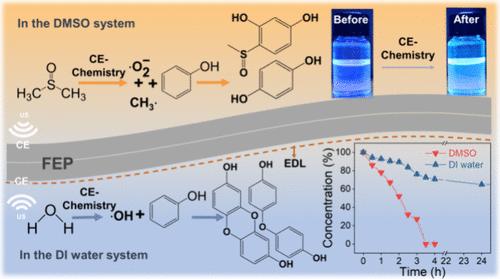Nonaqueous Contact-Electro-Chemistry via Triboelectric Charge
IF 14.4
1区 化学
Q1 CHEMISTRY, MULTIDISCIPLINARY
引用次数: 0
Abstract
Mechanochemistry revolutionizes traditional reactions through mechanical stimulation, but its reaction efficiency is limited. Recent advancements in utilizing triboelectric charge from liquid−solid contact electrification (CE) have demonstrated significant potential in improving the reaction efficiency. However, its efficacy remains constrained by interfacial electrical double-layer screening in aqueous solutions. This study pioneered chemistry in nonaqueous systems via CE for catalysis and luminescence. Density functional theory simulations and experiments revealed varying electron transfer capabilities and chemoselectivity of CE across different solvents. Phenol degradation via CE in dimethyl sulfoxide (DMSO) exhibited a rate over 40 times faster than that of traditional mechano-driven chemistry. A more intuitive comparison revealed that CE degradation of phenol in DMSO exhibits a 30-fold rate improvement compared to deionized water, where the degradation remains incomplete. Luminol oxidation by radicals generated solely via CE in DMSO eliminates the dependence on traditional catalysts and side reactions, establishing a pure and simple system for investigating the reaction mechanisms. A high and stable luminescence characteristic was maintained for 3 months, enhancing the imaging accuracy and stability exponentially. This study underscores the impact of triboelectric charge on reaction efficiency and chemoselectivity, establishing a new paradigm in nonmetal catalysis, mechanoluminescence, and providing profound insights into reaction kinetics.

通过三电荷实现非水接触式电子化学
机械化学通过机械刺激彻底改变了传统反应,但其反应效率有限。最近在利用液固接触电化(CE)产生的三电荷方面取得的进展显示了提高反应效率的巨大潜力。然而,其功效仍然受到水溶液中界面双层电屏蔽的限制。本研究开创了在非水体系中通过 CE 进行催化和发光的化学方法。密度泛函理论模拟和实验揭示了 CE 在不同溶剂中的不同电子转移能力和化学选择性。在二甲基亚砜(DMSO)中通过 CE 降解苯酚的速度比传统机械驱动化学反应快 40 多倍。更直观的比较显示,与去离子水相比,CE 在二甲基亚砜中降解苯酚的速率提高了 30 倍,而在去离子水中降解仍不完全。在二甲基亚砜中仅通过 CE 产生的自由基就能实现鲁米诺氧化,消除了对传统催化剂和副反应的依赖,为研究反应机制建立了一个纯粹而简单的系统。高稳定的发光特性可维持 3 个月之久,成倍提高了成像的准确性和稳定性。这项研究强调了三电荷对反应效率和化学选择性的影响,建立了非金属催化和机械发光的新范例,并对反应动力学提供了深刻的见解。
本文章由计算机程序翻译,如有差异,请以英文原文为准。
求助全文
约1分钟内获得全文
求助全文
来源期刊
CiteScore
24.40
自引率
6.00%
发文量
2398
审稿时长
1.6 months
期刊介绍:
The flagship journal of the American Chemical Society, known as the Journal of the American Chemical Society (JACS), has been a prestigious publication since its establishment in 1879. It holds a preeminent position in the field of chemistry and related interdisciplinary sciences. JACS is committed to disseminating cutting-edge research papers, covering a wide range of topics, and encompasses approximately 19,000 pages of Articles, Communications, and Perspectives annually. With a weekly publication frequency, JACS plays a vital role in advancing the field of chemistry by providing essential research.

 求助内容:
求助内容: 应助结果提醒方式:
应助结果提醒方式:


